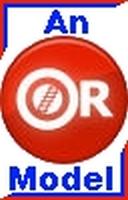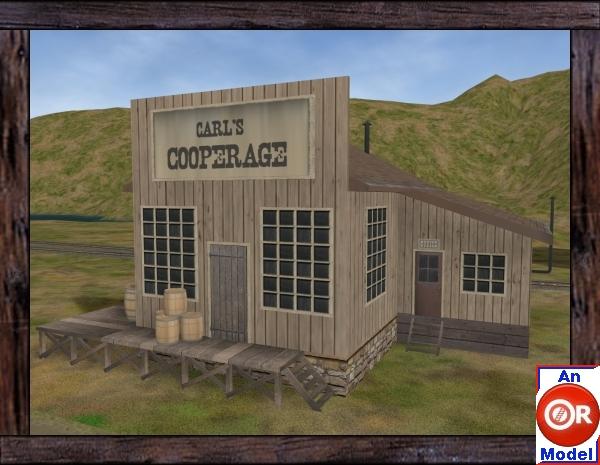Modeling projects: textures anything related to texturing or 'skinning'....
#2

Posted 13 August 2012 - 11:24 AM
OR handles 32bit/24bit standard skinning textures in square format, ie 32x32, 64x64, 128x128, 256x256, etc ~ through to 2048x2048 and it's rumoured also 4096x4096.
2d cabview texture protocols are a different ballgame. See the MSTS original documentation.
I only use ZLIB compression, so perhaps someone might like to comment on other compression protocols, thanks.
The above information may change at a future date.
Cheers Bazza
#3

Posted 13 August 2012 - 04:44 PM
Lindsay
#4

Posted 14 August 2012 - 12:16 AM
You are welcomed to use it for any OR models of your own.
Here's a blown up shot for clarity.

The original 64x100 bit map file can be DLed here;
 ORmodelLogo.zip (9.06K)
ORmodelLogo.zip (9.06K)
Number of downloads: 565
I'm using it like this;

:wub:
#5

Posted 14 August 2012 - 06:37 PM
At the moment, I believe that would be too difficult to define a certain standard, unless at some stage OR allows model functions (including additional shaders) that will not work in MSTS. Model complexity is also a factor.
I guess the best method of testing scenery type objects built for OR, is to choose a test route and install models in it. The route should be one that can easily be reinstalled and one you can avoid opening in MSTS.
Cheers Bazza
#6

Posted 21 August 2012 - 04:36 AM
That's putting it in a nut shell but is pretty easy to understand, IMHO. :pleasantry:
:oldstry:
#7

Posted 21 August 2012 - 05:34 AM
Quote
That's a good starter. :pleasantry:
Cheers Bazza
#8

Posted 21 August 2012 - 09:28 AM
Quote
At the moment, I believe that would be too difficult to define a certain standard, unless at some stage OR allows model functions (including additional shaders) that will not work in MSTS. Model complexity is also a factor.
I guess the best method of testing scenery type objects built for OR, is to choose a test route and install models in it. The route should be one that can easily be reinstalled and one you can avoid opening in MSTS.
Cheers Bazza
Quote
That's putting it in a nut shell but is pretty easy to understand, IMHO.
Guy's
I'm building models in what would be considered past the ability of MSTS to load. Their not in the terrible range but have more animation's and more poly's than some of the high poly models that currently work in MSTS. And although it has been said somewhere here that a few have 100,000 poly models in MSTS that cause no problems, they have few complex shapes in them. The complexity of shapes is what causes the problems in MSTS but have little affect on OR. OR is way more flexible when it comes to model's with no or few sub object's in their makeup. OR is the easy path to victory. Too bad some of the new aspiring modelers out there haven't discovered this yet.
Allen
ADDY; Open Rails will run models with NO textures. No kidding.
#9

Posted 21 August 2012 - 10:47 AM
#10

Posted 21 August 2012 - 04:51 PM
This is an Open Rails discussion forum. We're talking about model definition. Not what if's.
Allen
#11

Posted 21 August 2012 - 04:56 PM
MSTS can be surprisingly forgiving, but it also likes playing tricks on the unsuspecting. IME, each model is an experiment, whether it's for MSTS or OR, and some models win, some don't.
Cheers Bazza
#12

Posted 21 August 2012 - 06:04 PM
I suppose the short of it is this: take the hierarchy of any car or locomotive, break them into individual models, and use the kind-of .sd file to reassemble the hierarchy. The fun of reskinning suddenly morphs and expands into doing restructuring as well.
Such an approach would give OR the means to reuse complex models, like trucks (bogies) or (if the original modeler was kind enough to build it this way) to pull off a steam locomotive cab model and replace it with a different style (different windows, longer overhead, whatever).
#13

Posted 21 August 2012 - 08:11 PM
Cheers Bazza
#14

Posted 22 August 2012 - 12:43 AM
 Genma Saotome, on 21 August 2012 - 06:04 PM, said:
Genma Saotome, on 21 August 2012 - 06:04 PM, said:
Openbve works this way using the xxx.animation file. The file format has instructions for tranlating, rotating and scaling as well as changing textures of objects, all from some kind of definable external trigger. The primary use is to of course animate anything but it can also be used to construct complex objects out of a lot of simple objects (Note, it is specified one can do this in the animation file documentation). Makes it simple to make a library of regularly used items such as wheels and axles, boggies, coupling gear, pantographs, ladders etc.
Note, I have never used Openbve but I found some of its file formats suited my mind perfectly so I have used them in my own terrain simulation program.
Lindsay
#15

Posted 22 August 2012 - 02:56 AM

 Log In
Log In Register Now!
Register Now! Help
Help





